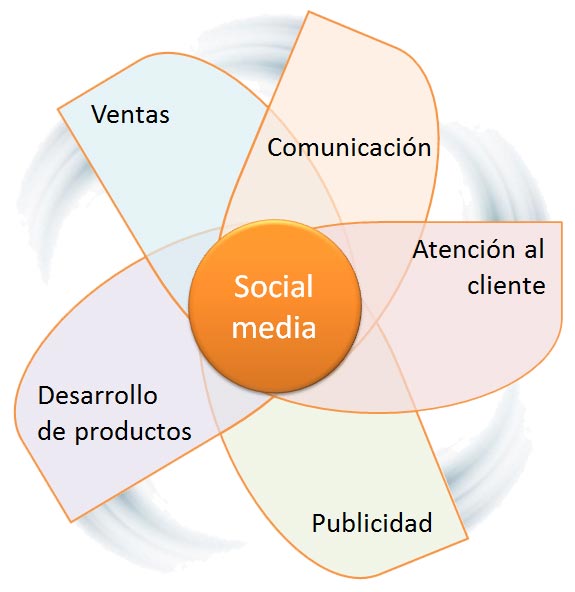Although new technologies represent a constant challenge for companies, they are also a great field of opportunities. Not only do we have to be on the Internet and have modern services and procedures that allow us to satisfy the needs of clients, we also have to be constantly up to date in the way we communicate with clients and users. Social networks are a great challenge for the company, but they can also provide extra differentiation that brings stability and benefits.
The communication within the company
A few years ago, not many,communication between the company and its clients, consumers or usersIt was practically one-way. The organization created the messages it deemed appropriate and launched them to the audience. This audience could accept them or not, but the only way they had to communicate with the company was by sending a letter or calling the Customer Service Department. The organization,The company also did not have many alternatives to find out what its clients, consumers and users thought.. Fundamentally, it consisted of hiring a market research agency or marketing consultant. In this model, communication was fundamentally in the organization-consumer direction.
With the first 2.0 experiences(media technology)Organizations launched applications on their websites that allowed them to receive information directly from their users. Fundamentally, information flowed from the organization to the consumer, although return channels began to be established. We can say that this communication became bidirectional, although with limitations.
Social networks in the company
Technology 2.0 has given way to the emergence of more participatory tools, which has allowed communication to evolve towards a new state.Clients, consumers and users have begun to talk among themselves, and not only as in the past, among friends, family or co-workers.. In this new environment, the power of influence of word of mouth is much greater. Not only do you reach many more people, but you do it much faster.Word of mouth no longer stops at geographic borders or time zones.
With social media in general and social networks in particular, you can share a recommendation or a bad review with hundreds of people with just one click.. Furthermore, if the recipients decide to share it with their network of contacts, this recommendation can reach thousands or millions of consumers. Let’s think for a moment about the cost of reaching millions of people through traditional (purchased) media and compare it with the cost of social networks, where consumers themselves can voluntarily spread their content and messages simply because they want to and can do so.
Social networks are a new means of communication, with the particularity of allowing direct and quick relationships to be established with an entire community of a few or millions of users and where each of them can also make their contribution.Social media are a powerful tool that, used well, can allow us to highlight our virtues, hide our defects and, in any case, better understand our environment and allow us to relate to it with a greater exchange of value.(that is, for the benefit of all).
Frequently,social networksThey end up being managed from the marketing area, in fact, we talk about social media marketing. However, these mediacan enhance the activity of each and every area of the company. For example, social networks can help find new suppliers, new partners, new and better candidates for vacant positions, contact potential clients or identify decision makers, in addition to offering an alternative for improving relationships. and the exchange of information.
Most big brands are integrating social media into their business models. Movistar, Apple, BMW or Coca-cola dedicate large resources to building customer communities. Places where they strive to relate to the customer as equals. These are not B2B (relationships between companies) or B2C (relationships between companies and customers) environments, we are talking about people, P2P (person to person).It is about talking, sharing thoughts, opinions, information, photos, videos, audios, data, resources, writings, games, events, reminders or any other personal activity..
Benefits of social networks for the company
Fundamentally, social networks facilitate communication and the exchange of information with clients, users, potential clients, suppliers, investors, candidates for vacant positions, competitors and any other relevant actor in the life of the company. Therefore, simply from this point of view we can assume that these are useful tools for the company and the professional; as useful as the telephone, email or corporate website can be. However,Social networks add a characteristic that previous media do not have: the ability to create community.
It must be taken into account that the number of social media users is immense; In fact, it is estimated that more than half of Internet users are on some social network. On the other hand, the traffic generated with the use of these media is much greater than that generated with the use of search engines (including Google or Yahoo), which gives us an idea of the relevance and impact of the information that Are exchanged.
We can say thatThe main benefits of social networks are based on their extraordinary capabilities to:
- Establish personal relationships
- Disseminate information without geographical or temporal limits
- Collect information from the environment in real time
- Low cost
People are social beings, we love belonging to groups that we support and from which we receive support, we need to share experiences, listen and tell stories, feel part of a broader structure in which we feel integrated (protected). The foundations on which the brand and loyalty are built have to do with this need for social connection and feeling of community.dad . Social networks are a good tool for building loyalty by promoting the quality of the relationship and boosting the perception of social support..

On the other hand, in social networks it is the case thata relatively small group of users can generate significantly large activity, there is also the possibility ofviral spread of information. Therefore, social networks can amplify the impact of any communication, of any information that is decided to be published. From a corporate point of view, social networks do not replace any other form of relationship, but rather become a complement to all of them (from advertising to public relations). In fact, it is a tool that can make any communication force more effective.
Regarding their abilities toinvestigate the environment , social networks can offer real-time details about the behavior of consumers, suppliers or competitors. This information can be very useful to improve customer retention activities, to protect the brand in times of crisis, warn of new market trends or to more accurately influence thousands or hundreds of thousands of consumers to prefer our brand, products or services over those of the competition. By the way, all this for a fraction of the cost of any other traditional means of communication.
This brings us to one of the most important benefits of social media:the cost. Most social media services are free, so implementing any of them does not require a large outlay. However, this should not lead us to the conclusion that the cost is zero. Generally,Most services require a considerable investment of time to get started and subsequently a significant level of activity must be maintained. This represents a cost in time or specialized resources..
Conclusions about social networks for the company
In summary, we can say that the main benefits that social media can bring us are the following:
- Strengthen the relationship with current clients.
- Improve awareness of our brand or company within our target market.
- Identify and attract new clients.
- Improve the effectiveness of our external relationships: with suppliers, partners or colleagues.
- Improve the effectiveness of our internal relationships: between departments, work groups, corporate policies, etc.
- Get to know our customers better: perceptions, satisfaction, commitment, etc.
- Know our environment better: competitors, suppliers, partners, candidates, etc.


